The history of espresso dates back to the late 19th century, originating in Italy. Espresso is the base for every coffee drink ever. It wasn’t until the early 20th century that Italy founded the espresso technique properly.
The history of the espresso is old, but the history of coffee is way older. So old that even the history was hard to get. Coffee entered the European hub in the 17th century, only back then steam-driven dedicated coffee machine was yet to be invented. Italy gifted the world espresso by the early 20th century.
Some people truly understood the need of creating coffee real fast. And someone sought to solve that problem initially; over the years, others took the job in hand and developed the process further to create the original technique to make espresso magic through the help of technology.
Stick with us to learn how the journey of espresso unfolds!
What Is Espresso And Espresso Machine?
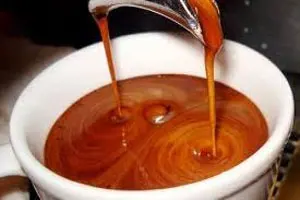
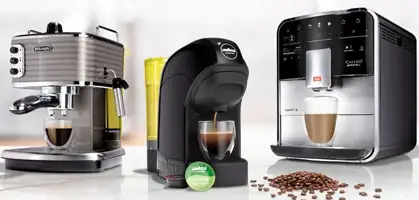
Espresso is coffee prepared by forcing hot water through finely-ground coffee beans. Since this is a concentrated form of coffee, the portion size is small, thus it is served as a shot rather than a large drink.
An espresso shot is the infusion of roasted finely ground coffee beans with hot water. You get bits of coffee fragments, aroma, and oils when you first have a taste.
Espresso can be taken directly or used as a base variant to form other forms of coffee. Adding water to dilute makes it an Americano, and adding milk in different ratios turns it into Latte or cappuccino.
To have a deeper understanding of these different types check out this video, Espresso Drinks Explained: Histories, Recipes, and More…
Generally, Espresso machines are a must to make regular espresso.
There are different types of espresso machines and there’s a detailed history and breakdown if you are interested.
When it comes to an espresso machine, the overall idea is simple.
There is a water tank and a boiler.
A small electric pump is used to transfer water from the water tank to the boiler, heat exchanger system is used to turn the water into steam. Then highly pressurized steam is passed through ground coffee to make a beautiful and aromatic cup of espresso.
History Of Espresso: The Origin In Italy
Going back to the roots of espresso we find Italy as the birthplace of espresso.
The coffee-making process is a very tedious and long one. It needed a long time to brew and it was a problem worth solving. Understanding the dilemma, Angelo Moriondo of Turin, took the challenge to solve the problem of the slow brewing process.
In 1884, he came up with a patent of the first espresso machine that used steam pressure to brew faster and stronger coffee. However, he didn’t promote this much and didn’t get further with the idea.
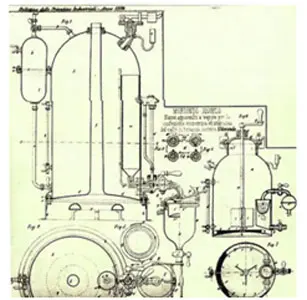
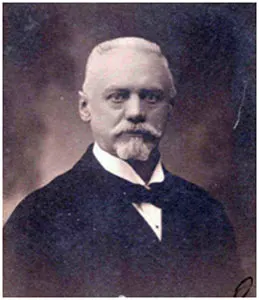
The main idea behind the espresso machine was to create coffee fast. If you translate the meaning of espresso from Italian, it roughly translates to fast. Later onward, for marketing purposes, a relation had been created with espresso and express train which both used steam for faster process. More about that later in the article.
Angelo Moriondo is the architect of the espresso machine. it was his patent based on which businessman Luigi Bezzera made a coffee brewing machine. Although initially, the base patent belonged to Angelo Moriondo, Luigi Bezzera made some much-needed tweaks to his patent to structure out a model, and also introduced a method for the espresso machine.
However, Bezzera didn’t have the marketing skills to take it even further, and that’s where Desiderio Pavoni came in. Pavoni had the funds to commercialize the espresso machines and they collaborated to make some key innovations in the design. Then in 1906, they were able to showcase their Espresso Machine at the Milan Fair.
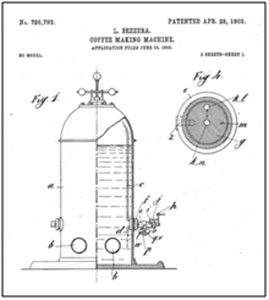
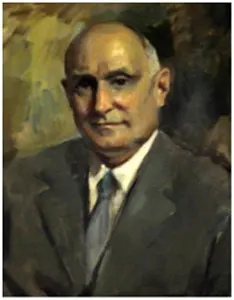
They called it “Cafe Espresso”; which meant coffee expressed at speed. This was the beginning and soon other people joined the espresso machine manufacturing industry.
One important name would be Pier Teresio Arduino. He commissioned a brilliant artist named Leonato Capello (known as the father of modern poster advertisement) to advertise espresso machines through creative posters.
Pavoni and Bezzera were originally selling the idea that “steam equals speed”. Their espresso machines are so fast that you could grab a cup of freshly brewed coffee from the side of a moving train.
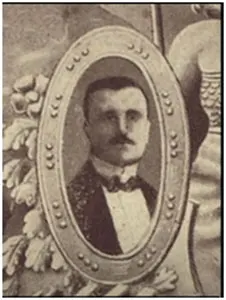
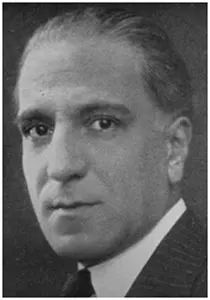
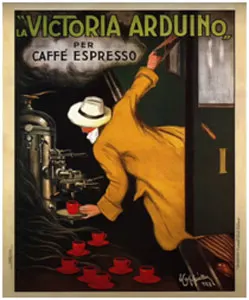
During 1948, a big innovation in the espresso machine came through Giovanni Achille Gaggia. He was able to come up with improved steam pressure that further enhanced the machine.
Over the years, other people and organizations joined in and new changes were made in the boiler (water heating chamber) and other functionalities to ultimately make the present-day modern espresso machines. The original idea or mechanism is still the same, but the process improved vastly over the years.
History Of Espresso Coffee: Timeline
1683: Coffee Came To Europe
The story takes us back to the times of the Ottoman empire. While the Ottoman army was hurriedly fleeing Vienna, they left bags of coffee behind. As a reward, this coffee was then gifted to the man for whom Vienna gained a victory.
That man was Franz Georg Kolshitzky who later on established the first coffee house in all of Central Europe
1884: Moriondo Made The First Espresso Machine Patent
It wasn’t until the late 17th century that patents were being formed to make the extraction of coffee faster. People back then enjoyed coffee but after ordering getting a cup of coffee took an eternity. Angelo Moriondo of Turin, Italy made a patent for the first-ever coffee brewing machine. Unfortunately, Moriondo didn’t have the capital to commercialize his machine, so no coffee brewing machine was made.
1906: Pavoni And Bezzera Created The First Functional Espresso Machine
In the fair of Milano, Luigi Bezzera and Desidero Pavoni presented the first-ever coffee brewing machine. They came together and made some essential changes to Moriondo’s patent, since Bezzera had the capital, he went on to commercialize this model. Thus, the espresso machine was born in 1906.
1920: Arduino And Capello Advertised The Espresso Machine Further
Pier Arduino of Italy, a famous businessman and a marketer went on to the international arena with the coffee brewing machines. With the help of an artist, a poster of a man in a yellow coat hanging out of the train was made. This made espresso fashionable for everyone.
With his marketing skills and the fashionable poster, Arduino started exporting the machines to other countries. Making a pathway for espresso to reach everyone
1933: New Innovations Came From Ernest Illy And Alfonso Bialetti
Espressos became so famous that both stovetop and automatic espresso machines were being simultaneously invented. Dr. Ernest Illy invented the automatic machine while Alfonso Bialetti came up with the first-ever stovetop machine. These inventions enabled people to enjoy espressos in the comfort of their homes.
2023: Present Day
A lot has evolved in the espresso-making process. The combination of science and technology made brewing espressos more convenient, so much so, that you get a cup of espresso in 30 seconds. Professional machines, as well as home use machines, have been designed by various brand names so that there is espresso for everyone.
Nowadays, you can easily find super automatic espresso machines (that can easily prepare espresso at the touch of a button), and powerful commercial espresso machines (that can produce a huge quantity of espresso without wearing off).
Modern Day Espresso
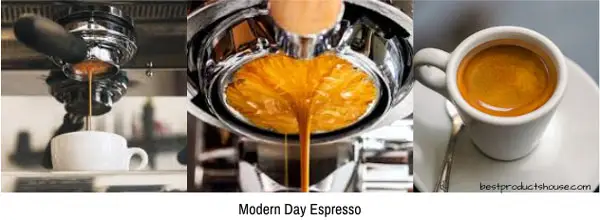
Back in the day, visual information was all baristas could capitalize on. Under-extraction, roast level, coarseness of the ground coffee was all forgotten about.
The freshness of roasted coffee beans was also not something people cared about previously. So, only for the sake of consistency of taste dosing was done till the basket filled to its brim; leading to a large amount of ground coffee usually left under-extracted.
The gold standard of how espresso should look is different from the present-day standard. The way the espresso fell from the spouts, you could tell how creamy, rich and decadent the mouthfeel of that pour would be in the old school espressos
It shows how decisions on the taste of an espresso drink were made solely on visual intel. A lot of new variables have been introduced in espresso-making which made the modern-day espresso different from the old school espresso.
Presently espresso is made taking in the factors like the type of coffee bean, roast level, coarseness of the ground coffee, amount of dosing plus many more unnoticed variables. When it comes to looks, it’s not the most stunning-looking cup of espresso. For the taste, I’d say it is more balanced and better now. Just a personal opinion not saying old-school espressos are bad.
Mainly to optimize the old school drink informed decisions have been made about the coarseness of the ground coffee, the way espresso falls from the spout, and how it looks in the cup. One might argue that the modern-day espresso is way better than the old-school espresso or it might even be the other way around.
To learn more about the technicalities and science behind espresso magic check out this video:
How About The Italian Coffee Culture In Present Day?
Would you be shocked if I tell you that you can still get the same espresso in Italy same as in 1940’s Italy? Well, don’t be. Although globalization might have changed the entire framework of the world. The coffee culture of Italy is still pretty much unchanged.
While you might be thinking this is insane, there’s more to it than meets the eye. Here is a guide to Italian coffee culture which will help you instantly pick up on the dos and don’ts.
How To Make Espresso?
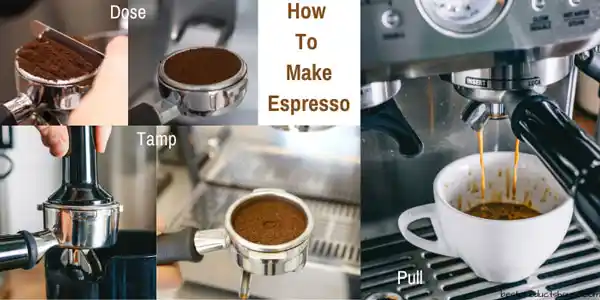
Things you need:
ground coffee beans, espresso maker, tamper, portafilter (single/double/pressurized/non-pressurized basket), and a cup.
Step – 1: Turning on the espresso maker. The most essential part of pre brewing is preheating the machine. While that is going on, take the portafilter and dose in the ground coffee beans. Then take the tamper and place it gently on top of the ground beans then press in lightly till the ground coffee is leveled.
Step – 2: Now that the portafilter is dosed and tamped, attach it to the brew head, placing a cup underneath to catch the extraction. Some espresso makers have the exclusive feature of extracting both single and double shots. See what shot size you dozed and choose the shot button accordingly.
Step – 3: It doesn’t take longer than 30 seconds to pull an espresso shot. After you’re done pulling the shot simply retract the portafilter from the brew head and that’s it, you’ve got your piping hot espresso shot ready to be served!
Read the detailed espresso making process here.
Frequently Asked Questions (FAQs)
Angelo Moriondo invented the first espresso machine in 1884 and filed a patent.
Espresso is much stronger than a regular cup of drip coffee.
Some say the father of modern espresso is Luizi Bezzera, and others would argue that Francesco Illy is the father of espresso.
In the year 1901, right after Luigi Bezzera devised the improved patent that enabled espresso making. This is when espresso was made using the first-ever steam-powered espresso machine.
Yes, an Italian man named Luigi Bezzera first introduced a steam-powered espresso machine. Working alongside Desidero Pavoni and Luigi Bezzera started working on commercializing the espresso machine.
Espresso is the real Italian coffee. Italy is the birthplace of the first coffee machine. The first espresso was made using this coffee machine. So, it is safe to say espresso is the real Italian coffee.
Locals use the term – “Caffè” or “caffènormale” when it comes to ordering espresso. In Italy espresso or caffèis the basic coffee.
Finland consumes the most coffee as per the International Coffee Organization.
Macchiato – when the espresso is mixed with just a hint of milk and to mark the presence of milk a little milk foam is spooned on top of the coffee.
There are many stories regarding this. One of them says – Herder Kaldi accidentally came across coffee berries sometime in 850 A.D. In the Ethiopian forests, goat herder Kaldi noticed how his goats were energized once they consumed these mysterious berries. That is how Kaldi discovered coffee berries.
Conclusion
The richness of the history of espresso runs as deep as the taste and texture of a cup of espresso. Right from the advent of the espresso machine, Italy gifted the world with a coffee wonder i.e., the espresso.
Starting from the invention of the espresso machine to the evolution of different variations of espressos across time, this coffee drink has put its mark on the globe as one of the leading beverages all across Europe.
In short, espressos or coffee drinks, in general, have become a staple for everybody. There’s a coffee for everyone and espresso is the base for all of them!




![6 Best Drip Coffee Maker With Grinder [2023] Best Drip Coffee Maker With Grinder](https://www.bestproductshouse.com/wp-content/uploads/2022/05/Best-Drip-Coffee-Maker-With-Grinder-100x70.jpg)
I really appreciate this post. I?¦ve been looking all over for this! Thank goodness I found it on Bing. You have made my day! Thx again
Would love to perpetually get updated outstanding site! .
I consider something genuinely special in this internet site.